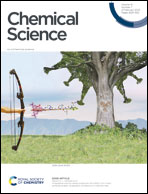Electrochemical oxidation of styrene to benzaldehyde by discrimination of spin-paired π electrons†
Abstract
The oxidation of styrene to benzaldehyde has been a considerable challenge in the electrochemical synthesis of organic compounds because styrene is more easily oxidized to benzoic acid. In this work, MnO2 with an asymmetric electronic configuration is designed to discriminate the spin-paired π electrons of styrene. One of these discriminated π electrons combined with reactive oxygen species (ROS), ˙OH, ˙OOH, etc., produced simultaneously on a MnO2/(Ru0.3Ti0.7)O2/Ti bifunctional anode, to form benzaldehyde via Grob fragmentation, rather than benzoic acid. However, only benzoic acid is obtained from the oxidation of styrene on the anodes MOs/(Ru0.3Ti0.7)O2/Ti, where MOs are other metal oxides with symmetric electronic configurations.

- This article is part of the themed collection: 2023 Chemical Science Covers


 Please wait while we load your content...
Please wait while we load your content...